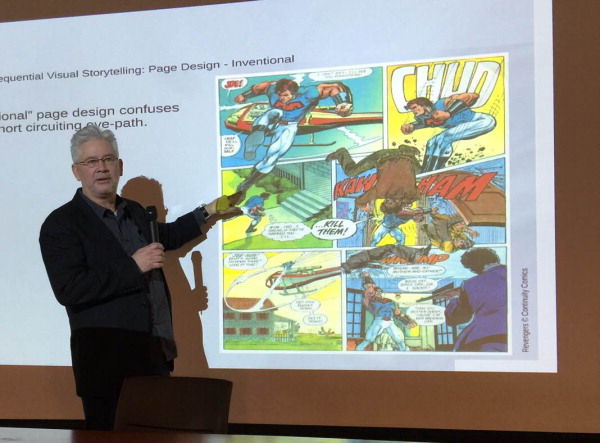By Nathan Phan, Special Writer
PRINCETON – With great storytelling power comes great storytelling responsibility, so a comic artist needs to know how to treat the audience.
That’s the advice from comic book artist, writer and editor Carl Potts. Working for Marvel Comics for more than 13 years as an executive editor, Potts shared his experience and career as a comic book creator March 24 at Princeton University in Dodd Auditorium.
Contributing to popular comic book characters like The Incredible Hulk and Doctor Strange, Mr. Potts is known for helping to develop the comic series Alien Legion and The Punisher comic series.
“The main overall goal as a visual storyteller is to keep your viewer immersed in the story,” said Mr. Potts. “Everything else that you do, that you are working on a comic, should be serving this ultimate goal.”
Throughout his presentation, Mr. Potts described the importance of storytelling elements in comics and offered plenty of advice for creating effective, powerful stories through a combination of narrative, visuals and especially sequential visual storytelling. Encompassing decisions ranging from framing and layout to the juxtaposition of visuals and text, sequential visual storytelling is what Mr. Potts believes is the core of comics, that the choices made through it can impact the story and experience for the reader.
In 2013, Mr. Potts published The DC Comics Guide to Creating Comics: Inside the Art of Visual Storytelling, a book teaching aspiring comic book creators the essential component of sequential visual storytelling in comics. A large portion of his talk included examples from the book to explain the different effects that using certain storytelling techniques can have in comics. In developing new visual storytelling methods, Mr. Potts said comic book artists must balance between practicality and inventiveness.
“In sequential visual storytelling, the principles are not hard and fast rules,” said Mr. Potts. “They are actually concepts that if you understand them, it should be liberating in a way that should help tell your stories in a clear and compelling way.”
Mr. Potts has served as a mentor for many leading figures in the comic book industry, including Mike Mignola, creator of the Hellboy comics, and Jim Lee, the co-publisher of DC Entertainment and Princeton University alumni of ‘86.
As an editor for Marvel, in order to better address issues that his peers struggled with, Mr. Potts read many cinematography books, especially since he found they shared storytelling aspects that he found to be useful in comics, and used them to train people in developing their storytelling skills.
Cinematography concepts like action flow continuity or the 180 Degree Rule of Cinema were incorporated into Mr. Potts’ comics and teachings, but he still made the distinction in how comics showcase a more non-linear experience compared to film and television. He described how the non-linear format of comics allows readers to reflect and review panels and information anytime, making the experience unique in being so interactive.
“In comics, the comics page itself might be a vertical frame, but you can break that space up in any number of shapes and sizes and unique panels, which gives comics a unique set of tools compared to any other visual medium,” said Mr. Potts.
For aspiring comic artists to develop into professionals, he emphasized the importance for them to achieve a wide range of skills and disciplines, especially in overcoming their drawing weaknesses and maintaining consistency in their drawing skills for readers.
“If there’s something significantly weaker, that’s what’s going to draw their [the readers’] attention, and that’s going to take them out of the flow of the story,” said Mr. Potts. “When you’re a comic book artist, you have to be able to draw everything real or imaginary at the same high level of convincing-ness.”
Mr. Potts expressed how important the special relationship is between comic creator, who leaves open spaces between the panels and tells the story reductively, and the comic reader, who must supply his/her own person knowledge and experience to fill in the gaps additively. Every comic reader’s experience is different, and Mr. Potts explained how comic creators, in creating their stories, find ways or ideas that interest many types of people.
The job of the creator is to give the reader what they expect, but not the way they expected it, said Mr. Potts.

